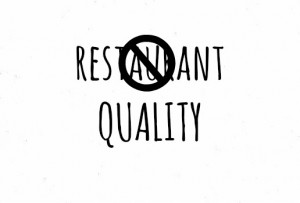The value proposition for dining out is changing. Restaurants have always been in the business of providing a product (food) and a service (waiting on the customer) that you can’t create for yourself. For years, large scale companies and progressive independents have dominated “restaurant quality food,” Food that these companies can introduce using their muscle, research and labor strength to bring unique flavors and provisions to the masses. They’ve distinguished “quality food” from grocery purchases by creating the perception that restaurants are able to procure higher quality ingredients.
In the last ten years, the introduction of online recipes, videos and blogs that showcase dishes and preparations once reserved for the culinary elite started to shift dramatically. The technology has been able to pull all of the ‘secrets’ out that have been traditionally kept tight in restaurant kitchens across the country. Also, the technology and introduction of commercial equipment, geared to be used in home kitchens, has unleashed a whole new realm of opportunities. The Food Network and Bravo TV took note and developed shows designed to demonstrate how so called “real chefs” prepare food in their home kitchens.
As more people started cooking, many, like myself, also started trying to find the secret recipes and mimic “restaurant quality” adaptations in our own kitchens. As a former restaurant owner, culinary enthusiast and someone who currently works for a large retail food company, Panera Bread, I’ve come to an abrupt fork in the road in regards to what “restaurant quality” means. Now home chefs have the resources to prepare this type of food in their own kitchens. The local food movement, for example, has prompted tradition vendors and suppliers to sell to a small, enthusiastic audience, which has opened the doors for independent restaurants and families to purchase products that simply weren’t available to them 15-20 years ago.
For example, a few years ago I was getting tired of buying coffee that was void of flavor. I lived in an area that did not sell any of the premium coffee purveyors or roasters that I craved. So I decided to learn about roasting. I took online classes, researched sustainable beans and techniques used by the top roasters in the world. I used consultants and industry professionals and spoke to long time industry veterans. Ultimately, I was able to create the perfect coffee at home.
This is just the way the world operates now. No company is “in the know” or privy to opportunities that people can’t create themselves.
So what does “restaurant quality” mean now? I believe it’s still a term that divides commodity based goods and items that are progressive and trend setting.The shift has now been pushed into overall quality, whether it’s a 1,500 unit restaurant chain, a local independent Deli, or a home in your kitchen.
In research and development, the term “open source” promotes universal access or free license to a product’s design or original blueprint, as well as mass redistribution of that design (recipe), including subsequent improvements to it by anyone. This was first spearheaded in the tech world and has now trickled down to cooking and recipe development.
We live in an increasingly open source society, where information is abundant. If you want to master the art of poaching an egg, just turn on Youtube and watch Thomas Keller. If you want to learn how to butcher a pig, you can visit a local butcher and take a class. You don’t have to accept that fact that you’re an outsider to the culinary underbelly, you can simply join the food obsessed masses and learn and master a culinary craft in your own home.
The times are changing, and it’s going to have major implications for restaurants.



